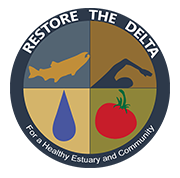by Barbara Barrigan-Parrilla (with the help of friends)
Last week, while our staff was away on leave, vacation, sick time, and other assorted in-Delta activities, DWR held a fisheries workshop on operations of the proposed Delta Conveyance Project. Colleagues from various organizations took an array of notes and shared the following with us. We are editing their notes to share with our followers, with a bit of color commentary; otherwise, we wouldn’t be acting like ourselves.
The webinar presentation indicates that the agencies are proposing several changes in operations of the Delta tunnel compared to WaterFix, and these changes are grounded in wholly inadequate operational criteria. The project may have moved from two tunnels to one, but the operating conditions for water quality are getting worse. This of course would lead to more harmful algal blooms in the Delta.
Moreover, the suggested operations are worse for salmon than WaterFix. Restoring the salmon fishery is clearly not a priority for the Department of Water Resources.
The first big change could significantly impact Delta water quality and in-Delta diversions: DWR is now proposing to use the new Delta tunnel in the summer months for water exports, which they indicate would likely reduce carriage losses for water transfers. It is not clear that this would allow them to reduce Delta outflow (as they have suggested) given that the Central Valley Project will still have to pump from the South Delta. This maneuver seems like another step towards DWR’s goal of eliminating the obligation to control salinity in the Delta. (See slide 47)
In contrast, the equally flawed old WaterFix project at least included a “preference” for South Delta pumping for the months of July to September, up to 3,000 cfs (“Jul–Sep: Prefer south delta intake up to total pumping of 3,000 cfs; No specific intake preference beyond 3,000 cfs.”). This info can be found in the WaterFix Final Document of June 2017 BA at 3-96.
A couple of other notes regarding the proposed operations are also important. They reveal how Delta water quality needs and standards will be ignored for DWR’s export project.
They are proposing to count water diversions from the new intake as exports under D-1641 (e.g., for the import/export ratio under D-1641) (slide 46), which they refused to do in WaterFix (BA at 3-96). [It is unclear if they are computing Sacramento River inflow for purposes of D-1641 above or below the intakes. ]
They are proposing bypass flows past the new diversion that are wholly inadequate and significantly weaker than what was required in WaterFix, allowing for water diversions that will reduce salmon survival and would significantly worsen impacts for fall-run Chinook salmon (slide 52).
WaterFix included “an unlimited number of fish migration events that would trigger the low-level pumping diversion rates” (aka pulse protection, see NMFS biop at 100, 731-732) – the presentation proposes to allow only two pulse protection events. (Slide 53)
WaterFix included an offramp from pulse protection whenever bypass flows were greater than 35,000 cfs (NMFS BiOp at 731-732), whereas the presentation proposes to allow full diversions when flows are greater than 26,285 cfs (and with lower bypass flows required after pulse protection is triggered, so that full pumping could occur after 2 pulse protection events when flows are only 18,750 cfs) (slide 52)
WaterFix required unlimited pulse protection for December through June (NMFS BiOp at 751), although it only specifically protected winter-run and spring-run sized fish. The presentation seems to propose pulse protection would only apply from December to April (slide 52)
WaterFix required low-level pumping whenever there was a pulse of migrating salmon (which was defined in the ITP as 5 winter-run or spring-run length fish in the Knights landing catch index) unless flows were greater than 35,000 cfs (see NMFS BiOp at 731-732). The presentation allows for more than low-level pumping outside of the 2 pulses when flows are as low as 15,000 cfs (before any pulse flow protection events) down to 9,000 cfs (after 2 pulse protection events).
WaterFix required minimum bypass flows of 7,000 cfs in October and November, and 5,000 cfs the rest of the year (plus pulse protection). (see BA at 3-81). The presentation seems to suggest bypass flows of 5,000 cfs year-round. (slide 52)
They are proposing to meet the existing outflow requirements from March to May. However, this still allows for massive reductions in Delta outflow in the winter months and does not require adequate spring Delta outflow. (slide 46) It appears similar to the inadequate Delta outflow requirements in WaterFix (BA at 3-86).
For Restore the Delta, we are proud of our efforts to engage honestly in the process to improve the project. It can never be said that we did not try and that the people of the Delta were not reasonable.
However, as we feared, there is no commitment by DWR to restore the estuary, protect water quality for Delta communities, or heal and replenish salmon fisheries. This is why the Delta Conveyance Project will remain a failed project for California. There is nothing co-equal about it. It’s about extracting our precious water resources for the benefit of certain powerful groups at the expense of Californians – environmentally and economically.

